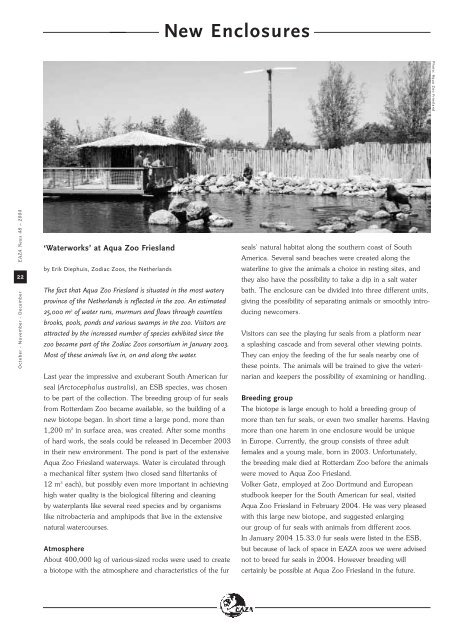EAZA NEWS 48 - European Association of Zoos and Aquaria
EAZA NEWS 48 - European Association of Zoos and Aquaria
EAZA NEWS 48 - European Association of Zoos and Aquaria
You also want an ePaper? Increase the reach of your titles
YUMPU automatically turns print PDFs into web optimized ePapers that Google loves.
<strong>EAZA</strong> News <strong>48</strong> – 2004<br />
22<br />
October - November - December<br />
‘Waterworks’ at Aqua Zoo Friesl<strong>and</strong><br />
by Erik Diephuis, Zodiac <strong>Zoos</strong>, the Netherl<strong>and</strong>s<br />
The fact that Aqua Zoo Friesl<strong>and</strong> is situated in the most watery<br />
province <strong>of</strong> the Netherl<strong>and</strong>s is reflected in the zoo. An estimated<br />
25,000 m3 <strong>of</strong> water runs, murmurs <strong>and</strong> flows through countless<br />
brooks, pools, ponds <strong>and</strong> various swamps in the zoo. Visitors are<br />
attracted by the increased number <strong>of</strong> species exhibited since the<br />
zoo became part <strong>of</strong> the Zodiac <strong>Zoos</strong> consortium in January 2003.<br />
Most <strong>of</strong> these animals live in, on <strong>and</strong> along the water.<br />
Last year the impressive <strong>and</strong> exuberant South American fur<br />
seal (Arctocephalus australis), an ESB species, was chosen<br />
to be part <strong>of</strong> the collection. The breeding group <strong>of</strong> fur seals<br />
from Rotterdam Zoo became available, so the building <strong>of</strong> a<br />
new biotope began. In short time a large pond, more than<br />
1,200 m2 in surface area, was created. After some months<br />
<strong>of</strong> hard work, the seals could be released in December 2003<br />
in their new environment. The pond is part <strong>of</strong> the extensive<br />
Aqua Zoo Friesl<strong>and</strong> waterways. Water is circulated through<br />
a mechanical filter system (two closed s<strong>and</strong> filtertanks <strong>of</strong><br />
12 m3 each), but possibly even more important in achieving<br />
high water quality is the biological filtering <strong>and</strong> cleaning<br />
by waterplants like several reed species <strong>and</strong> by organisms<br />
like nitrobacteria <strong>and</strong> amphipods that live in the extensive<br />
natural watercourses.<br />
Atmosphere<br />
About 400,000 kg <strong>of</strong> various-sized rocks were used to create<br />
a biotope with the atmosphere <strong>and</strong> characteristics <strong>of</strong> the fur<br />
New Enclosures<br />
seals’ natural habitat along the southern coast <strong>of</strong> South<br />
America. Several s<strong>and</strong> beaches were created along the<br />
waterline to give the animals a choice in resting sites, <strong>and</strong><br />
they also have the possibility to take a dip in a salt water<br />
bath. The enclosure can be divided into three different units,<br />
giving the possibility <strong>of</strong> separating animals or smoothly introducing<br />
newcomers.<br />
Visitors can see the playing fur seals from a platform near<br />
a splashing cascade <strong>and</strong> from several other viewing points.<br />
They can enjoy the feeding <strong>of</strong> the fur seals nearby one <strong>of</strong><br />
these points. The animals will be trained to give the veterinarian<br />
<strong>and</strong> keepers the possibility <strong>of</strong> examining or h<strong>and</strong>ling.<br />
Breeding group<br />
The biotope is large enough to hold a breeding group <strong>of</strong><br />
more than ten fur seals, or even two smaller harems. Having<br />
more than one harem in one enclosure would be unique<br />
in Europe. Currently, the group consists <strong>of</strong> three adult<br />
females <strong>and</strong> a young male, born in 2003. Unfortunately,<br />
the breeding male died at Rotterdam Zoo before the animals<br />
were moved to Aqua Zoo Friesl<strong>and</strong>.<br />
Volker Gatz, employed at Zoo Dortmund <strong>and</strong> <strong>European</strong><br />
studbook keeper for the South American fur seal, visited<br />
Aqua Zoo Friesl<strong>and</strong> in February 2004. He was very pleased<br />
with this large new biotope, <strong>and</strong> suggested enlarging<br />
our group <strong>of</strong> fur seals with animals from different zoos.<br />
In January 2004 15.33.0 fur seals were listed in the ESB,<br />
but because <strong>of</strong> lack <strong>of</strong> space in <strong>EAZA</strong> zoos we were advised<br />
not to breed fur seals in 2004. However breeding will<br />
certainly be possible at Aqua Zoo Friesl<strong>and</strong> in the future.<br />
Photo: Aqua Zoo Friesl<strong>and</strong>
















